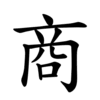商
| ||||||||
Translingual
| Stroke order | |||
|---|---|---|---|
 | |||
Han character
商 (radical 30, 口+8, 11 strokes, cangjie input 卜金月口 (YCBR), four-corner 00227, composition ⿱⿱亠丷冏)
References
- KangXi: page 194, character 32
- Dai Kanwa Jiten: character 3803
- Dae Jaweon: page 415, character 9
- Hanyu Da Zidian: volume 1, page 288, character 6
- Unihan data for U+5546
Chinese
| trad. | 商 | |
|---|---|---|
| simp. # | 商 | |
Glyph origin
| Historical forms of the character 商 | ||||
|---|---|---|---|---|
| Shang | Western Zhou | Warring States | Shuowen Jiezi (compiled in Han) | Liushutong (compiled in Ming) |
| Oracle bone script | Bronze inscriptions | Chu Slip and silk script | Small seal script | Transcribed ancient scripts |
 |
 |
 |
 |
 |
| Characters in the same phonetic series (商) (Zhengzhang, 2003) | |
|---|---|
| Old Chinese | |
| 商 | *hljaŋ |
| 蔏 | *hljaŋ |
| 螪 | *hljaŋ |
Etymology
Traditionally it is considered that 商人 (shāngrén) is so named because this term originally refers to people from Shang dynasty, who tend to do business.
Schuessler, 2007 lists two possible origins:
Pronunciation
Definitions
商
- trade; commerce; business
- businessman; dealer
- (mathematics) quotient
- (music) the second note in the Chinese pentatonic scale
- (~朝) Shang Dynasty
- to discuss; to consult
See also
Compounds
Derived terms from 商
|
|
|
Japanese
Readings
- Go-on: しょう (shō, Jōyō)←しやう (syau, historical)
- Kan-on: しょう (shō, Jōyō)←しやう (syau, historical)
- Kun: あきなう (akinau, 商う, Jōyō)←あきなふ (akinafu, historical)
Etymology
From Middle Chinese 商 (syang, “commerce”).
Noun
Korean
Hanja
商 • (sang) (hangeul 상)
- This term needs a translation to English. Please help out and add a translation, then remove the text
{{rfdef}}.
Vietnamese
Han character
商 (thương)
- This term needs a translation to English. Please help out and add a translation, then remove the text
{{rfdef}}.
This article is issued from
Wiktionary.
The text is licensed under Creative
Commons - Attribution - Sharealike.
Additional terms may apply for the media files.